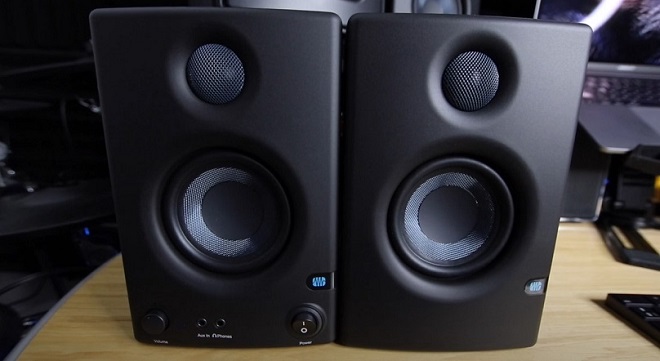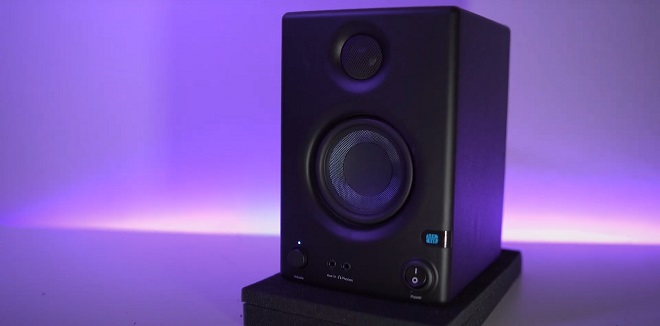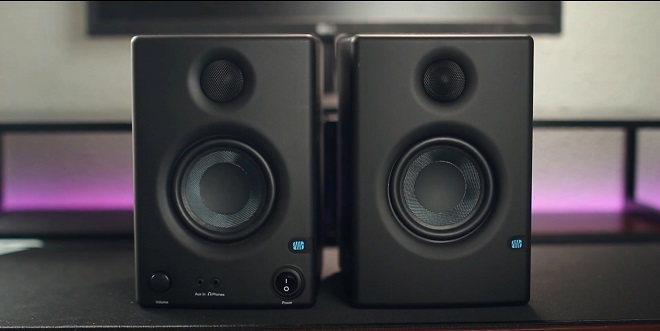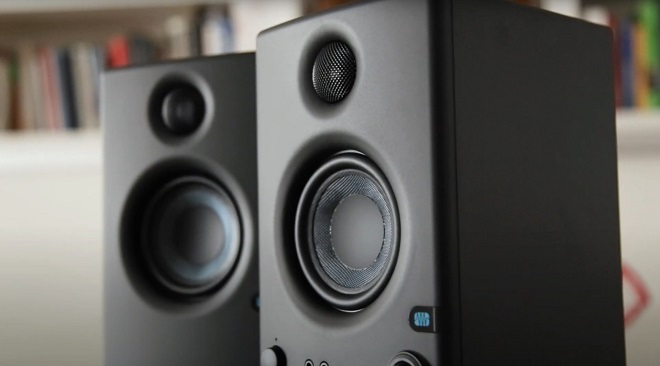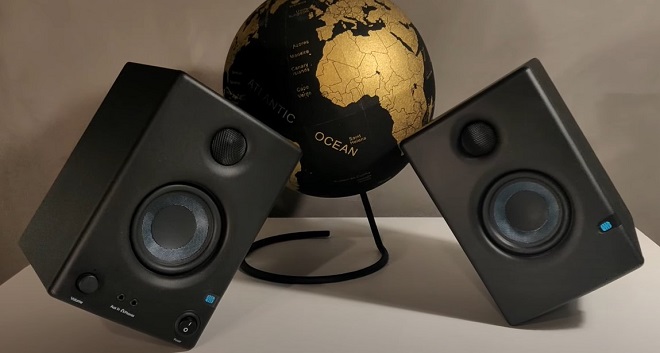If I’m going to buy a set of studio monitors, they must have a wide optimal listening area. When I’m listening to something exciting, I want the freedom to be able to move around in my home studio and still be able to clearly hear the high frequencies.
You might think that means I need a big set of studio monitors to achieve this. But as the PreSonus Eris E3.5 desktop monitors prove, that’s not the case. I put them to the test in my own home studio and found that these small but mighty desktop monitors offer excellent sound quality at a great price point. They’re perfect for small and mid-size studio spaces.
Read on for my complete PreSonus Eris E3.5 review…
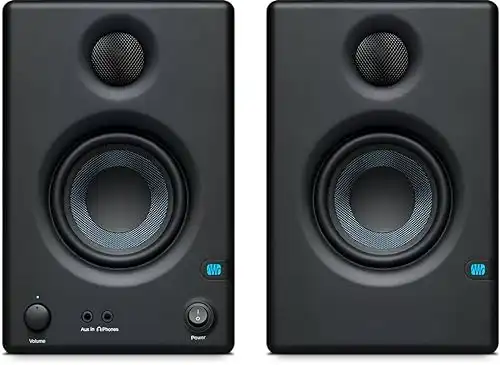 PreSonus Eris E3.5-3.5" Near Field Studio Monitor (Pair) (E3.5)
PreSonus Eris E3.5-3.5" Near Field Studio Monitor (Pair) (E3.5)
Top Features
- Accurate Sound
- Solid Bass
- Accurate frequency response
- Excellent Value for a Low Price
- Great Sound Reproduction for Music Recording, Video Production, and Gaming
What’s so special about the PreSonus Eris E3.5 monitors?
The most impressive thing about these monitors is the value for the price. Compared to other studio monitors, which can cost $1,000 or more; a pair of Eris E3.5 monitors sells for around $100 (they’re currently $89.99 at the time of this review update, but that price does change slightly from time to time).
For those who want monitors, at a budget price, which give a high-quality reference sound, the Eris E3.5 monitors are the leaders in the low-cost category.
Who are the PreSonus Eris E3.5 monitors made for?
The Eris E3.5 monitors are designed for use in the home studio, for those who make video productions for social media (such as YouTube videos), software developers/designers who create video games, and for a substitute for regular multimedia speakers. As an instructional designer, I often use them when working on various eLearning projects.
Construction
The woofer (low-frequency transducer) is 3.5 inches (89 mm) and made from woven Kevlar composite. The tweeter (high-frequency transducer) is one inch (25 mm) and has ultra-low-mass with a silk-dome. An acoustic port that sends sound out the back of the monitor creates an excellent bass-frequency sound.
Design
Looks might not seem important, but what can I say, I can be superficial at times. These monitors look spectacular. The design is clean and aesthetically pleasing with plenty of nice features.
On the front are the power on/off (with LED), volume knob, and stereo mini-plug jacks (one-eighth inch) for an auxiliary input and headphones jacks. These monitors have an integrated stereo-headphones amplifier built-in.
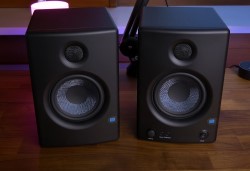
On the back of the left speaker, there are high- and low-frequency acoustic tuning controls, balanced left and right one-quarter-inch TRS jack inputs, left and right unbalanced RCA jack line inputs, and an IEC connector to plug in the power cord for the internal power supply.
Use speaker wires to connect the separate black and red outputs (+/-) from the back of the left powered monitor to the correct black (-) and red (+) inputs on the back of the passive right speaker.
Features
There is protection built-in for RF interference, output current limiting, overheating prevention, and protection from transient and subsonic frequencies.
The amplifier has a soft-start feature. This eliminates any popping sound on power-up, which I appreciate. These monitors are rated for 50 watts of power (25 watts per side) and use Class AB bi-amplification.
Size
These monitor speakers have plenty of power, packed in a cabinet with a small footprint. These speakers are an excellent choice for a recording studio with limited space.
The dimensions of the monitors are width 5.6 inches (14.2 cm) by depth 6.4 inches (16.3 cm) by height 8.3 inches (21.1 cm). This means that they can be hung on the wall, placed on a studio desk, put on a shelf, mounted on stands, and placed anywhere in a home studio. Even though these are professional studio-quality monitors, they can also be used at home, in the office, or school dorms.
Watch this video to see how the PreSonus Eris E3.5 reference monitors look in various spaces. See how they look next to a laptop for a size comparison. Video game development is the perfect type of project for these speakers to get a full-range sound reproduction.
In the next video, an audio engineer from PreSonus, Rick Naqvi, shows the one-inch Kevlar tweeter, which is a feature I think makes the Eris E3.5 monitor exceptional. Nobody would have blamed them for using a three-quarter-inch tweeter that is the type most likely found in multimedia monitors of this size. After all, that would save money and help make this monitor low cost. However, this would also negatively affect the sound. PreSonus went with the higher-quality choice.
PreSonus used the one-inch tweeter because that is what makes these reference monitors sound so accurate. Another helpful feature is the ability to acoustically tune the monitors depending on the room’s characteristics.
Sound Quality
The sound quality of the Eris E3.5 monitors coming from the one-inch Kevlar tweeter and the 3.5 inch Kevlar woofer is excellent. These monitors are bigger than average speakers and this is a stand-out feature for the price.
These speakers are not super-heavy in the low-end frequencies; however, I found that they are very punchy and sound crisp and clean in the low-end without making the mixed sound overly muddy or boomy. The high-end frequency reproduction is superb.
For music recording and mixing you will be able to hear all the instruments accurately thanks to its ability to comfortably handle low and high frequencies with clean and balanced sound.
Setup
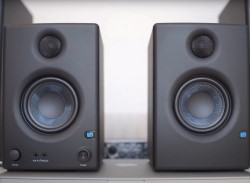
The setup of these monitors is very easy. You take them out of the box, and then connect the powered speaker to the passive one using speaker wire. Connect an input signal to one of the choices of inputs on the rear or the mini-plug input on the front. Place the speakers in position. Connect the power code and switch the monitors on.
That’s it. You are ready to go.
You also have the option of using an audio interface to amplify the signal as desired. If you want more bass sound, you can then add a subwoofer.
Calibration
Calibration is necessary to fine-tune your monitors to the characteristics of the room.
You want to first make sure you calibrate based on the volume of the sound. The best range of volume is between 75 to 80 dB for a smaller home studio. For a larger room, you might use 85 dB. Then, you want to calibrate the stereo image of the sound to have the left and the right side of the sound have the same volume. Use the volume buttons on the back of the monitor to make them match.
To calibrate, you use two pieces of equipment, an SPL meter and a tone generator that makes pink noise. You can download a free app for your smartphone that is an SPL meter. It needs to perform C-weighted and slow response-time measurements. Most recording applications have a tone generator function built-in. You need to have pink noise and be able to adjust the volume.
Follow the detailed instructions in the video to do the calibration.
Pros and Cons
Here are the things that I think are good and not so good about the PreSonus Eris E3.5 studio monitors:
Pros
- Beautiful compact design.
- Reproduces sound accurately.
- Larger than average tweeter and woofer.
- Low price.
- Durable enough for constant daily production use.
Cons
- If you use the unbalanced RCA jacks, the sound is better when also using an audio interface.
- To get a heavier bass sound, you need to add a subwoofer.
PreSonus Eris E3.5 Technical Specifications
Here are the technical specifications of the Eris E3.5 monitors:
Inputs
- One stereo one-eight-inch.
- Two balanced one-quarter-inch TRS.
- Two unbalanced RCA.
Performance
- Frequency Response: 80 Hz to 20 kHz
- Crossover Frequency: 2.8 kHz
- Amplifier Power: 25 watts per speaker
- LF Driver: 3.5 inch
- HF Driver: One-inch silk dome
- Peak SPL (at one meter): 100 dB
- Input Impedance: 10 kΩ
User Controls
- Volume Range: A-type taper
- MF Control: Variable (minus 6 to plus 6 dB, center 100 Hz)
- HF Control: Variable (minus 6 to plus 6 dB, center 10 kHz)
Protection
- RF Interference
- Output-Current Limiting
- Over-Temperature
- Turn-On/Off Transient
- Subsonic Filter
- External Mains Fuse
Power
100-120V ~50/60 Hz or 220-240V ~50/60 Hz
Cabinet
Medium-Density Fiberboard that is Vinyl-Laminated
Dimensions and Weight
- Width: 5.6 inches (141 mm)
- Depth: 6.4 inches (162 mm)
- Height: 8.3 inches (210 mm)
- Weight (per pair): 6.4 pounds (2.9 kilograms)
PreSonus Eris E3.5 vs. Mackie CR3
The Mackie CR3-X is the model that replaced the Mackie CR3. The Mackie CR3-X is a multimedia monitor designed for home recording studios and gaming. The Mackie CR3-X monitors have the same power as the Eris E3.5 have, which is 50 watts (25 watts per speaker).
The Mackie CR3-X has a three-inch woofer and a three-quarter-inch tweeter. The tweeter is smaller than the one-inch tweeter found on the Eris E3.5. This makes the high-frequency sound of the Mackie CR3-X less robust than the Eris E3.5 monitors.
The Mackie CR3-X and the Eris E3.5 both have a rear port that improves the bass sound. In the front panel, there is a 3.5 mm mini-plug headphone connection. When you plug in the headphones, this turns off the speaker’s sound. That is convenient. I use this feature as a kind of quick mute-switch, especially when I want something to continue to play while I talk over it while working with another person.
The inputs on the back of the powered speaker include an unbalanced 3.5 mm mini-plug line-in connection, unbalanced RCA inputs, and one-quarter-inch TRS inputs (balanced or unbalanced). The terrific variety of connections allows signal inputs from a mixer, a computer soundcard, an audio interface, or a mobile device.
There is also a switch to choose the side of the stereo sound the powered speaker is placed. The other speaker is passive and receives its signal from the two speaker wire connections coming from the powered speaker.
Unlike the Eris E3.5, which has the ability to make acoustical tuning adjustments, the Mackie CR3-X does not have any ability to be fine-tuned for room conditions.
PreSonus Eris E3.5 vs. Edifier R1280T
The Edifier R1280T and the Eris E3.5 monitors are a similar size and cost around the same.
The Edifier R1280T monitors have four-inch (10.16 cm) primary woofers and a dedicated tweeter in each unit, which share 42 watts of power (21 watts per speaker). This is lower than the Eris E3.5, which has 50 watts (25 watts per speaker). That weakness alone is enough for me to choose the Eris E3.5 monitors over the Edifier R1280T model.
Another problem with the Edifier R1280T is the limited inputs. There are two RCA audio jacks. Dual RCA inputs allow using two audio sources such as a PC and an auxiliary source. However, there are no mini-plug or TRS jacks for input.
The right speaker holds adjustment knobs for master volume, bass, and treble. Having the adjustment for bass and treble is not desirable for studio monitors because to mix properly you want to have accurate sound reproduction and not use any equalization to color the sound. The bass distorts when set to full volume.
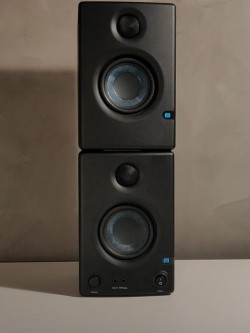
The dimensions of the Edifier R1280T monitors are by 5.7 inches (14.5 cm) width by 7.7 inches (19.6 cm) depth by 9.2 inches (23.4 cm) height, which is a nice compact size. The cabinet finish on the side is a fake wood grain vinyl coating and grey paint on the top and bottom. For me, this is really cheesy and I don’t like it.
The right speaker is powered and the left speaker is passive and connects with the included eight-feet long (2.4 meters) speaker wire. It comes with a remote that only controls volume and has a mute button. To me, having a simple volume remote is useless.
The Edifier R1280T is a multimedia monitor designed for listening to music and games. It can serve as a reference monitor for audio mixing but it is not designed for that. I am not at all impressed with the Edifier R1280T except to say that they make me appreciate the Eris E3.5 monitors all that much more.
Why the PreSonus Eris E3.5 Monitors are So Much Better
I’m the kind of man who does not like to waste my cash. I want value.
The Eris E3.5 gives a flat response and does not add unwanted boost. Standard multimedia speakers, which cost around this same price, do not come close to providing such accurate reference sound. The Eris E3.5 benefits from the same research and development put into the larger monitor models made by PreSonus.
The Kevlar tweeter is a full one-inch size. This is the same size as PreSonus uses in the larger models of monitors made by them. Most multimedia speakers have a smaller tweeter that is three-quarters of an inch. The Kevlar woofer is 3.5 inches. This compares nicely to other multimedia monitors in this class that only have a smaller three-inch woofer. I can really hear the difference and I am sure you will be able to hear this too.
What do others think about the PreSonus Eris E3.5 monitors?
Like me, this reviewer in the video below loves the Eris 3.5 monitors. He uses them for video game playing, home studio recording, and video editing/production. He used them in the creation of his video review about them. He agrees with me that there is a huge sound quality that comes from these monitors for a very low cost.
Another expert did a follow-up Eris 3.5 review after using the monitors every day for two years to do music production and video editing. He calls them the most underrated monitors for $100 on the market. He is as happy with them as the day he bought them. They are must-have speakers according to his review. He recommends using them with an audio interface to improve the stereo separation that is not very good when using the unbalanced RCA jacks.
Final Thoughts
I am in love with the PreSonus Eris E3.5 studio monitors and there is nothing you can do to break us apart.
For me, they have the best sound quality for such a small footprint and low cost. They make other monitors in this class take a back seat in comparison.
Sure you can spend ten times more to get better performance but that is too much money for me to spend. To consider other monitors, check out my guide to the Best Home Studio Monitors.
 PreSonus Eris E3.5-3.5" Near Field Studio Monitor (Pair) (E3.5)
PreSonus Eris E3.5-3.5" Near Field Studio Monitor (Pair) (E3.5)
Top Features
- Accurate Sound
- Solid Bass
- Accurate frequency response
- Excellent Value for a Low Price
- Great Sound Reproduction for Music Recording, Video Production, and Gaming


